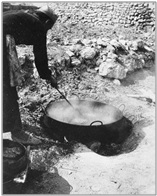John Brown Love Story – by Si Podolin
Editor’s note: At the initiative of ALBA board member Chris Brooks, who maintains the online biographical database of US volunteers in Spain, the ALBA blog will be regularly posting interesting articles from historical issues of The Volunteer, annotated by Chris.Over the next three months, Blast from the Past postings will showcase articles about the American volunteers who served in the Artillery. Many of these articles ran in The Volunteer during Ben Iceland’s tenure as editor. Iceland, who served in the Artillery, recruited several of his fellow artillerymen to document their experiences. Iceland also shared his own experiences in a series of articles he originally wrote in the early 1940s. Together these articles shine a light on some lesser known American volunteers.
John Brown Love Story
Si Podolin
[Originally published in The Volunteer, Volume 8, Number 2, October 1986.]
The only cook we had in The John Brown Battery who did not commit gastronomical homicide was a Cuban by the name of Domingo. We shared a villa in a bombed-out village near Cabeza del Buoy on the Estremadura Front. There was a small piece of roof and wall left, but we fixed it up real chic; we even had a picture of Pasionaría [1] on one wall and one of Stalin on the other; Stalin’s picture had not yet been relegated to the shithouse of history.
I shared a straw mattress I had fabricated with a family of field mice and several anti-Franco female scorpions who liked to cuddle up to my warm body on cold nights.
Domingo was a former baseball player, a pitcher, with The Batista Pirates, and he had so much smoke on the ball that no one in the outfit could hold him. I tried and ended up with a hand like a piece of raw steak. He had beautifully developed muscles that glided beneath his sleek ebony skin, and a perpetual smile on his gnome-like face.
Domingo was an exceptional cook, but the delicacies he prepared for a few select comrades on the QT were culinary marvels. For example:
Paella con Lagarto. Lagarto is a huge green lizard that sits up in the olive trees and ogles you with its big sentimental glassy eyes. When frightened it jumps off the limb of the tree, hits the deck like a ton of bricks, and takes off through the dust with its tail straight up like the mast of a ship. The Spaniards say when you kill lagarto he does not die until sundown, but that is pure folklore, for once he’s in the pot he’s sure dead, even if he still tastes like he’s alive.
We had no seafood for the paella and because the lizard had a slightly fishy taste it made a fine substitute, especially if we had traded our ‘mata quinto’ (recruit-killer) cigarettes with a peasant for a chicken.

Field Kitchen – Kitchen Frying Hamburgers, L-W, near Huesca, Box 1, Folder 11, 177_185042 (ALBA Photo 177, International Brigades Archives, Moscow: Selected Images, Folder 185, 58th BN in Operations for the Republican Army in Spain, 1937-1938.
Then there was El Guisado con Gato, a fine fricassee cooked with a cat and varied wild mountain spices. The first time we enjoyed the dish was when a commando of Spanish comrades flushed an old tom from some ruins and took off after it across the hills above Toledo, tally hoeing like a pack of British aristocrats after a fox. They came back with the beast hanging by the neck, its red tongue and eyes popping from its head. Meat was scarce in those days.
The one failure of the Cuban was an assignment of jackass meat we got from the central quartermaster’s stores. No matter how much finesse Domingo put into his work the donkey remained stringy, black, with a slight pungent nuance of jackass shit.
The French had a big police dog that disappeared one fine day. They invited us to partake of the fiesta, but for sentimental reasons we refused. The French are the best chef’s in the world, but they’ll eat almost anything.
Everyone loved Domingo, not only for his culinary propensities, but just because he was that kind of guy. He fell in love with a beautiful Andalusian peasant girl, knocked her up and married her. When I say beautiful I am underwriting; she looked like she had just stepped out of a Goya painting.
When we received orders to pull out, that the war was lost, he could not get permission to take Carencita with him. We had been cut off by the fascists in the Battle of the Ebro and we were to embark in Valencia aboard a Spanish freighter flying a French flag. There was no room for wives or novías. Between Valencia and Barcelona the sea was lousy with Franco submarines, to say nothing of bombers. From Barcelona we were to make our way across the French frontier.
Domingo refused to abandon his pregnant wife and stayed behind when we pulled out. I often wonder if he made it. How could a black man hide in Franco Spain? Perhaps he took on the identity of a Moorish mercenary? Did they put him against a wall? Did he rot in a Franco prison with the tens of thousands of other Republican combatants?
Every time my wife and I go across the frontier into Spain we make all the working class quarters, hoping to find Domingo cooking one of his exquisite paellas in a local Bodega.
If anyone has news of comrade Domingo kindly let us know, for we still love him like a brother.
[1] Isidora Dolores Ibárruri Gómez (9 December 1895 – 12 November 1989) known as La Pasionaria, the passion flower. She was a communist politician who is famous for her rallying cry of “No Pasarán” or “They shall not pass.”













